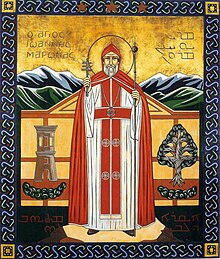John_Maron
John Maron
Syriac bishop and saint
John Maron (Arabic: يوحنا مارون, Youhana Maroun; Latin: Ioannes Maronus; Syriac: ܝܘܚܢܢ ܡܪܘܢ; 628, Sirmaniyah or Sarmin, present Syria – 707, Kfarhy, Lebanon), was a Syriac monk from what is now modern Syria. and the first Maronite Patriarch. He is revered as a saint by the Maronite Church and universal Catholic Church, and is commemorated on March 2. He died and was buried in Kfarhy near Batroun, in Lebanon, where a shrine is dedicated to him.[1]
Jérôme Labourt, writing in the Catholic Encyclopedia says that John Maron's "very existence is extremely doubtful ... if he existed at all, it was as a simple monk".[2] French theologian Eusèbe Renaudot similarly held doubts regarding John Maron's existence.[2] Other scholarship has assessed John Maron as having existed and served as Maronite Patriarch when invasions by Byzantine emperor Justinian II were repulsed and the Maronite people gained a greater degree of political independence.[3]
